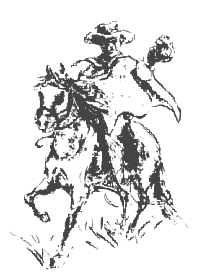Heavenly Gait
Written by Mr. Verne Albright, Noted Authority and Historian.

The doctors told Sharon Reynolds that her riding days were over.
A lifetime in the saddle had caused discs in her lower back to deteriorate, and the experience of riding had shifted from exhilarating to painful
to downright dangerous. Sharon risked permanent damage and even paralysis if she continued doing what she enjoyed most, riding horseback.
"It was the worst news of my life," she said, "and yet -- contrary to my wishes
-- I had to admit the doctors were right. Every time I rode, it wouldn't be thirty seconds before I'd start feeling those painful twinges. It
kept getting worse and worse." In an unexpected turn of events, Sharon had the
opportunity to ride a horse recently imported from South America.
"It was unbelievable! The ride was so smooth, it felt as if the
horse was floating!" she exclaimed. "There was no pain or discomfort ...
just the marvelous sensation of being able to ride again."
What made the difference? Sharon had ridden a Peruvian Paso horse. Over a
century ago, a visitor to South America wrote: "Horseback riding is a vigorous
form of exercise except in Peru, where breeders have managed a triumph over
nature. They have created a horse which moves by means of a very smooth amble.
These horses are greatly sought-after, for to ride one is much the same as being
seated in a chair."
Peruvian horses have long been esteemed for the smooth way they
cover ground. In fact, the Spanish word paso refers to the gait that
produces their incredibly smooth ride.
For those who have yet to understand and appreciate the artistry of Peruvian
horses, the paso gait may appear somewhat peculiar. Most people are accustomed
to seeing the motions of trotting horses with legs moving in a diagonal pattern.
In contrast, the Peruvian Paso's inborn gait is lateral. The legs are moved
individually, and the sequence is such that the Peruvian always has at least two
feet on the ground, much the way a baby crawls. The "paso llano" gait has no
"aerial phase", with all four feet in the air. These factors combine to provide
that splendid, gliding ride for which the Peruvian is widely celebrated.
But there's more! In addition to the smoothness, there's fabulous style to the
Peruvian's way of going. The significance of this style is difficult to
describe. Luis de Ascasubi did it best. "There are times in life," he said,
"when one longs for the superfluous. And in this world, dominated by
statistics, efficiency and materialism,
it's a joy to see [a Peruvian Paso] come dancing down the road, rhythmically
tapping out his beat, glowing with good humor."
Ascasubi was discussing what the untrained eye might see as "wasted energy,"
expended as these majestic horses exhibit their "termino." The Peruvian is the
only horse with termino, a unique, graceful and flowing movement of the
forelegs. The front knees bob high and the forelegs arc toward the outside as
the horse strides forward. It looks something like the arm motions of a swimmer
doing the Australian Crawl. Combined with the breed's carriage, presence and
energy, termino completes a beautiful picture, one for which Peruvian horses are
justly famous.
Peruvian Paso horses are unique. In fact, a humorist once called them: "the
animal which most nearly resembles a horse." A Canadian breeder was a bit more
sentimental when he referred to them as: "the tablet on which the Peruvians have
chiseled their culture." Both descriptions point out that this breed is unlike
any other.
If you have enjoyed reading these
articles you can find a complete updated collection, and more,
in by Verne R. Albright |
| Go to Pasos on the Web | This
page created and maintained by
"Pasos on the WEB!" First Posted December 11, 2000 Last Checked October 02, 2008 |